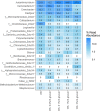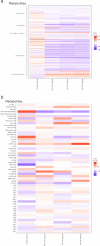Modulation of gut microbiota, blood metabolites, and disease resistance by dietary β-glucan in rainbow trout (Oncorhynchus mykiss)
- PMID: 36404315
- PMCID: PMC9677660
- DOI: 10.1186/s42523-022-00209-5
Modulation of gut microbiota, blood metabolites, and disease resistance by dietary β-glucan in rainbow trout (Oncorhynchus mykiss)
Abstract
Background: Prebiotics are known to have a positive impact on fish health and growth rate, and β-glucans are among the most used prebiotics on the market. In this study, rainbow trout (Oncorhynchus mykiss) were treated with a β-1,3;1,6-glucan dietary supplement (at a dose of 0 g, 1 g, 10 g, and 50 g β-glucan per kg of feed). After 6 weeks, the effect of the β-glucan was evaluated by determining the changes in the microbiota and the blood serum metabolites in the fish. The impact of β-glucan on the immune system was evaluated through a challenge experiment with the bacterial fish pathogen Yersinia ruckeri.
Results: The microbiota showed a significant change in terms of composition following β-glucan treatment, notably an increase in the relative abundance of members of the genus Aurantimicrobium, associated with a decreased abundance of the genera Carnobacterium and Deefgea. Furthermore, analysis of more than 200 metabolites revealed that the relative levels of 53 metabolites, in particular compounds related to phosphatidylcholines, were up- or downregulated in response to the dietary supplementation, this included the amino acid alanine that was significantly upregulated in the fish that had received the highest dose of β-glucan. Meanwhile, no strong effect could be detected on the resistance of the fish to the bacterial infection.
Conclusions: The present study illustrates the ability of β-glucans to modify the gut microbiota of fish, resulting in alteration of the metabolome and affecting fish health through the lipidome of rainbow trout.
Keywords: Gut microbiota; Metabolite response; Oncorhynchus mykiss; Prebiotic; β-glucan.
© 2022. The Author(s).
Conflict of interest statement
The authors declare no competing interests.
Figures





Similar articles
-
Citrus flavonoids, β-Glucan and organic acid feed additives decrease relative risk during Yersinia ruckeri O1 biotype 2 infection of rainbow trout (Oncorhynchus mykiss).PeerJ. 2020 Mar 4;8:e8706. doi: 10.7717/peerj.8706. eCollection 2020. PeerJ. 2020. PMID: 32181057 Free PMC article.
-
Immunomodulatory effects of dietary β-1,3-glucan from Euglena gracilis in rainbow trout (Oncorhynchus mykiss) immersion vaccinated against Yersinia ruckeri.Fish Shellfish Immunol. 2012 Jul;33(1):111-20. doi: 10.1016/j.fsi.2012.04.009. Epub 2012 Apr 21. Fish Shellfish Immunol. 2012. PMID: 22548789
-
Effect of dietary β-glucan on growth, survival and regulation of immune processes in rainbow trout (Oncorhynchus mykiss) infected by Aeromonas salmonicida.Fish Shellfish Immunol. 2017 May;64:56-67. doi: 10.1016/j.fsi.2017.03.015. Epub 2017 Mar 7. Fish Shellfish Immunol. 2017. PMID: 28286256
-
Diet type dictates the gut microbiota and the immune response against Yersinia ruckeri in rainbow trout (Oncorhynchus mykiss).Fish Shellfish Immunol. 2014 Oct;40(2):624-33. doi: 10.1016/j.fsi.2014.08.021. Epub 2014 Aug 21. Fish Shellfish Immunol. 2014. PMID: 25150450
-
GAS1: A New β-Glucan Immunostimulant Candidate to Increase Rainbow Trout (Oncorhynchus mykiss) Resistance to Bacterial Infections With Aeromonas salmonicida achromogenes.Front Immunol. 2021 Jul 6;12:693613. doi: 10.3389/fimmu.2021.693613. eCollection 2021. Front Immunol. 2021. PMID: 34295335 Free PMC article.
Cited by
-
Exploring the effects of dietary inulin in rainbow trout fed a high-starch, 100% plant-based diet.J Anim Sci Biotechnol. 2024 Jan 22;15(1):6. doi: 10.1186/s40104-023-00951-z. J Anim Sci Biotechnol. 2024. PMID: 38247008 Free PMC article.
-
Combined Dietary Administration of Chlorella fusca and Ethanol-Inactivated Vibrio proteolyticus Modulates Intestinal Microbiota and Gene Expression in Chelon labrosus.Animals (Basel). 2023 Oct 26;13(21):3325. doi: 10.3390/ani13213325. Animals (Basel). 2023. PMID: 37958080 Free PMC article.
-
Dietary supplementation of β-1, 3-glucan improves the intestinal health of white shrimp (Litopenaeus vannamei) by modulating intestinal microbiota and inhibiting inflammatory response.Front Immunol. 2023 Jan 30;14:1119902. doi: 10.3389/fimmu.2023.1119902. eCollection 2023. Front Immunol. 2023. PMID: 36793729 Free PMC article.
References
-
- FAO. The state of world fisheries and aquaculture 2020. Rome: FAO; 2020. 10.4060/ca9229en.
-
- O’Neil J. Tackling drug-resistant infections globally: final report and recommendations. 2016.
-
- Hill C, Guarner F, Reid G, Gibson GR, Merenstein DJ, Pot B, et al. The International Scientific Association for Probiotics and Prebiotics consensus statement on the scope and appropriate use of the term probiotic. Nat Rev Gastroenterol Hepatol. 2014;11:506–514. doi: 10.1038/nrgastro.2014.66. - DOI - PubMed
-
- Ghanei-Motlagh R, Gharibi D, Mohammadian T, Khosravi M, Mahmoudi E, Zarea M, et al. Feed supplementation with quorum quenching probiotics with anti-virulence potential improved innate immune responses, antioxidant capacity and disease resistance in Asian seabass (Lates calcarifer) Aquaculture. 2021;535:736345. doi: 10.1016/j.aquaculture.2021.736345. - DOI
Grants and funding
LinkOut - more resources
Full Text Sources
